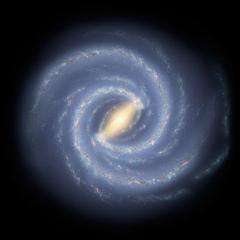July 23, 2009 weblog
Physicists on the prowl for dark matter

(PhysOrg.com) -- 95%. That is the percentage of the known Universe that is missing. As in it is not there. Or at least if it is there, we can't see it. We call this unseen stuff "dark matter". That has been well known for sometime. What is trickier in answering is why? Why is it that 95% of the universe is made up of this so-named "dark matter?" An even trickier question is where? As in where is this dark matter? It is those two questions that have plagued physicists for decades. Dark matter, by its own definition cannot be seen, hence its name. So how do we "see" it, how do we know "where" to look?
Physicists have been trying to think of various "indirect" ways to "see" dark matter for decades. Now physicists at the Institute for Advanced Study in Princeton, NJ and the Max Planck Institute for Physics in Munich are ready to test their methods, The Economist reports.
Even though we have not been able to see dark matter, that doesn't necessarily mean it doesn't exist. For one thing, there is the issue of velocity. Galaxies spin with such high velocity that if there was not a force holding them together, they would fly apart. The name of this invisible force? Dark Matter. However it may no longer be "invisible". At least not at the subatomic scale, where for the first time, a team of physicists has gathered evidence.
Evidence that is of high energy positrons from space. Positrons are of course the antimatter versions of electrons. Some theorists posit that they are formed through the mutual annihilation of WIMPs. WIMPs are weakly interacting massive particles and they are a type of dark matter. Physicists have done calculations which would suggest that the product of interactions between WIMPs and antiWIMPS would be positrons.
Dr. Michael Kuhlen at IAS has been working on this problem for sometime. Now they have an explanation that lends credence to this theory. Along with his team Kuhlen has been working on a computer model of the halo of dark matter in which the Milky Way is thought to be entrenched. Kuhlen takes us to 50 million years after the Big Bang. This is around the time the first galaxies are forming. From this vantage point Kuhlen and his team calculate the ensuing interacting of 1 billion WIMPS over the following 13.7 billion years.
In this model, Kuhlen also makes use of the Sommerfeld effect. Proposed by German physicist Arnold Sommerfeld in the 1930s who said that there is a quantum-mechanical process that causes particles to interact with each other more so in some circumstances and less so in others. The model found that with the effect in place dark matter should annihilate much more readily than previously thought. Kuhlen and his team report their work in the current edition of Science.
If Kuhlen and his team are found to be correct, they would have explained the overt prescence of high energy positrons. They would have also found a second signal from the deteriorating dark matter. These would be in the form of gamma rays emanating from the Milky Way. Satellite based telescoes such as Fermi should pick these up with relative ease.
Halfway around the globe, Pierre Colin of the Max Planck Institute for Physics in Munich are using a very different source to figure out the same problem. While Kuhlen is using Milky Way Galaxy as a whole, Colin is concerned with a very small slice of the galaxy. Colin and his colleagues believe that using the shadow of the moon in order to work out whether the positrons actually come from the conflicting dark matter. They are using telescopes looking for Cherenkov radiation, created when cosmic rays hit the upper-level atmosphere.
On July 9th, Dr. Colin presented his research to the International Cosmic Ray Conference in Lodz, Poland. He showed that the moon blocks electrons and positrons in the same way it blocks light creating electron and positron shadows. However, since these particles are charged, they also interact with the Terran magnetic field. These interactions deflect the two types of particles in different directions due to opposite charges.
This results in separate electron and positron shadows. While it is normally impossible to discern Cherenkov radiation generated via positrons with those generated via electrons, Colin thinks it can be done. This would be done by looking at the edges of the shadows when the moon is between the telescope and the cosmic ray source. Through this they would determine whether the high-energy positrons math the theoretical value. They would be able to bring dark matter out of the shadows.
© 2009 PhysOrg.com


















